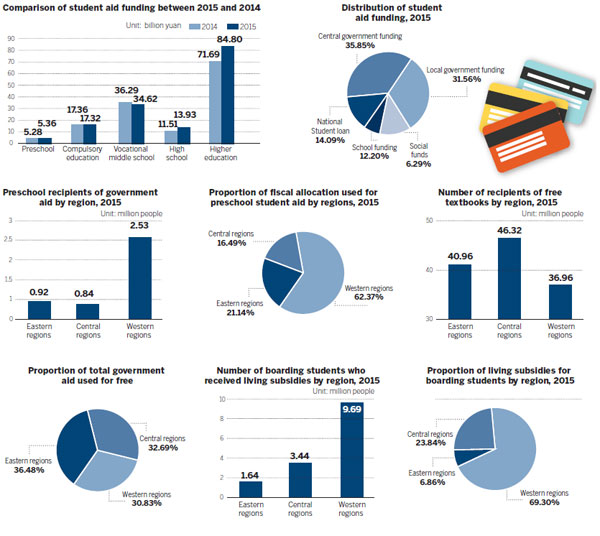China Student Aid Development Report 2015
Educational equality is an important foundation of social equality. Ensuring students from impoverished families enter school and complete their studies smoothly, is an important measure to promote educational equality and a crucial means to alleviate poverty.
In 2015, through the joint efforts of the financial and educational departments of the central and local governments, as well as schools at all levels, student financial aid in China made new breakthroughs.
The national student financial aid system was enhanced through increased subsidies, with more special aids targeting at registered poverty-stricken students, orphans and disabled students. New policies were also implemented to prevent students dropping from school due to financial problems.
1. The national student aid policies were further improved.
In 2015, focusing on weak links of student aid policies, the financial and educational departments of central and local governments adjusted and introduced student financial aid policies according to the regional level of economic and social development and the need of students from impoverished families. The national student financial aid system covering learning stages from preschool to postgraduate education was improved to affect more students.
1.1 New national student aid policies have been developed.
The repayment period for national student loans was extended to the school year plus 13 years, no longer than 20 years. The loans' grace period was extended from two years to three years.
The government-funded interest discount would be provided when the student pursues further degrees or suspends schooling owing to bad health. The establishment of a new reimbursement-based aid was proposed, providing subsidies to students who lost capacity to work due to injury. The mechanism was first established in Jiangsu, Hunan, and Shandong provinces.
The annual standard of national tuition assistance for high schools and secondary vocational schools grew from 1,500 yuan ($224.9) per student per year to 2,000 yuan per student per year.
The tuition exemption policy for high school students was enhanced. After the fifth Plenary Session of the 18th CPC Central Committee, the Ministry of Finance, Ministry of education and the State Council Leading Group Office of Poverty Alleviation and Development explored ways to waive the tuition of students from impoverished families on record. The new tuition exemption policy was specially designed for minority students in high schools in the Tibet, Inner Mongolia and Guangxi Zhuang autonomous regions, as well as Qinghai, Sichuan, Hainan and Hunan provinces.
The range for secondary vocational schools' tuition exemption eligibility was also expanded in regions such as Hainan, Shanghai, Guizhou, Henan and Gansu. Up to 2015, 17 provinces have accomplished tuition exemption for all secondary vocational school students.
Regions such as Shanghai, Jiangsu, Fujian, and Guangxi further enlarged the range of students receiving living expenses' subsidies while attending boarding schools. The scope of coverage was expanded to non-boarding students from impoverished families or all boarding students. Yunnan, Xinjiang, Inner Mongolia and Qinghai further increased these subsidies.
Aid policy was specially drafted for students from extremely impoverished families on record in Guizhou, Shandong, Chongqing, Shaanxi and Gansu. Aid systems for disabled orphans were built up in provinces such as Hebei, Zhejiang, Jiangsu, Anhui and Guangdong.
1.2 The national student financial aids have formed system.
The national student financial aid system in China covers all learning stages, both public and private schools and all students from impoverished families.
Under the new policy, local governments are the primary sources of financial aid and the central government provides subsidies as rewards to them. Preschool-age children from impoverished families, children with disabilities and orphans enrolling in kindergarten are also eligible for financial support.
For students in compulsory education (grades one to nine), the government provides free education for all students and offers free textbooks for rural students and students from impoverished urban families. The government also distributes free Chinese dictionaries to rural students, provides subsidies for boarding students from impoverished families and provides nutritious meals for students in impoverished areas.
For students in secondary vocational education, the dominant student aid mode is to forego tuition and grant national stipends, while supplementary aid provides students with aid through workplace internships and funding from schools and social sponsors.
For students in high school education, the dominant model is to provide national stipends, and the supplementary aid provides school funds and funds from social donations.
For undergraduate students, the government provides student aid in multiple ways, including national scholarships and stipends, loans, school stipends, work-study programs, free education for normal students, tuition subsidies for retired soldiers, subsidies for enlisted students and students from impoverished families, meal subsidies, tuition exemption and a "green channel", which allows freshman register at colleges or universities even when they cannot pay the full tuition.
For post-graduate students, the government provides student aid in the forms of national scholarships and stipends, loans, school stipends, tuition subsidies for retired soldiers, subsidies for enlisted students, and the "green channel".
2. Funding of student aid kept growing substantially.
Funding of student aid kept growing in 2015, which surpassed 150 billion yuan for the first time, an increase of 10 percent from 2014. The sum of subsidies for free textbooks and nutritional programs reached 45 billion yuan.
2.1 The total funding surpassed 150 billion yuan.
In 2015, a total of 156.03 billion yuan was spent on subsidizing 84.33 million students receiving preschool education, compulsory education, secondary vocational education, high school education and higher education. The funding increased by 13.90 billion yuan, or 9.78 percent, from 2014. The amount of government funding in student financial aid has maintained rapid growth for nine years, since the government started building the national student financial aid system in 2007.
A total of 5.36 billion yuan was used to subsidize 4.58 million preschool children. About 17.32 billion yuan was put into school boarding for students during compulsory education, supporting 14.77 million people.
About 15.67 million students at secondary vocational schools received financial support, totaling 34.62 billion yuan. About 7.90 million high school students received financial subsidies, the sum of which reached 13.93 billion yuan, an increase of 2.41 billion yuan, or about 20.99 percent, from 2014. More than 41 million college and university students were supported by subsidies of nearly 85 billion yuan, up 13.11 billion yuan, or 18.29 percent.
China has focused on increasing subsidies for college and university students, especially for graduate students, reducing financial burdens for their families. In 2015, subsidies for them grew rapidly. The total sum of national student loans increased by 5.29 billion yuan, or 31.66 percent, from 2014. National stipends for graduates, scholarships and the "Three Assistances" for graduates increased by 5.04 billion yuan, 3.13 billion yuan and 749 million yuan respectively.
2.2 Free textbooks cost 18.7 billion.
In 2015, nearly 16.3 billion yuan was provided by financial departments for subsidizing free textbooks to 124 million students. About 1.10 billion yuan came from the central government. About 5.33 billion yuan was from local governments. And 2.40 billion yuan was provided by financial departments of local governments for subsidizing free textbooks to 56.98 million primary and high school students.
2.3 26.4 billion yuan was provided for nutrition programs .
In 2015, student nutrition programs were carried out in about 89,000 schools, subsidizing over 21.11 million students. Over 20 billion yuan from the central government was provided for the nutrition programs. Pilot programs were developed in 720 counties of 25 provinces, covering about 45,000 schools, supporting 11.23 million students. Abut 6.30 billion yuan was provided by financial departments of local governments.
3. Government played the key role in the national student financial aid.
The funding of national student financial aid primarily came from government funding, supplemented by schools' funds and social donations.
3.1 Government spent more than 100 billion yuan on student financial aid, an increase of 6 percent from 2014.
In 2015, 105.19 billion yuan was provided for student financial aid by government funding, an increase of 6.24 billion yuan, or 6.31 percent, from 2014. About 55.94 billion yuan came from central government, up 4.10 billion yuan, or 7.92 percent. More than 49.25 billion yuan was from local governments, an increase of 2.14 billion yuan, or 4.54 percent.
Government funding was the main source of national student subsidies, accounting for 67.42 percent of the total. About 35.85 percent was from the central government while 31.56 percent was from local governments.
Over 5.17 billion yuan, was spent on subsidizing preschool education, accounting for 96.51 percent of the total funding. Subsidies for school boarding during compulsory education all came from government funding. More than 26.7 billion yuan was put into subsidies for vocational secondary schools, which constituted 77.15 percent. About 12.84 billion yuan provided by government funding made up 92.17 of subsidies for high school students. Over 43.15 billion yuan, or 50.88 percent of the sum of subsidies for college and high school, came from government funding.
3.2 Universities provided over 22 billion yuan for national student loans, up 31 percent from 2014.
2015 was the first year after the standard of national student loans was improved. Student loans supported by colleges and universities reached 21.99 billion yuan, up 5.29 billion yuan, or 31.66 percent from 2014. It is an important part of subsidies colleges and universities provided, which compromised 25.93 percent of the total.
3.3 Schools and society provided 28.8 billion yuan, an increase of 9 percent.
In 2015, 28.86 billion yuan of subsidies came from the revenue of schools and donation of enterprises and institutions, social groups and individuals, an increase of 2.33 billion yuan, or 8.76 percent, from 2014, accounting for 18.49 percent of the total subsidies. And 19.04 billion yuan was from the revenue of schools, making up 12.20 percent of the total subsidies. Subsidies of about 9.81 billion yuan came from the donation of enterprises, social groups and individuals, which constituted 6.29 percent of the total.
4. All policies were implemented effectively.
In 2015, financial and educational departments at all levels promoted the increase of aid funds, and the intensity and the effectiveness of aid policies.
4.1 Subsidies for preschool children
In 2015, nearly 4.58 million children in kindergartens received financial support from various channels. More than 4.29 million of them were supported by the government. About 238,200 were supported by kindergartens and 48,400 received charitable donations. The sum of all subsidies reached nearly 5.36 billion yuan. Some 5.17 billion yuan came from the government, 158 million yuan came from kindergartens and 29.20 million yuan from charitable donations.
1) Aid from the government
In 2015, government at all levels helped more than 4.3 million children - about 11.38 percent of all children at kindergartens nationwide - with financial subsidies. In western China, about 2.53 million children received financial aid, accounting for 22.78 percent of all enrollment. In central China, 839,500 children received financial aid, about 6.19 percent. About 921,900 children received financial aid in eastern China, more than 7 percent of the total enrollment.
Government at all levels provided financial aid of 5.17 billion yuan. There was 1 billion yuan from the central government to support kindergartens nationwide, accounting for 19.32 percent of the total, 2.19 billion yuan, or 42.33 percent from provincial-level, 377 million yuan from city-level, or 7.29 percent, and 1.61 billion yuan from county-level, or 31.06 percent.
By region, about 3.23 billion yuan, or 62.37 percent, was spent in western China. About 853 million yuan, or 16.49 percent, was spent in central China. About 1.09 billion yuan, or 21.1 percent, was used in eastern China.
2) Aid from kindergartens
In 2015, about 238,200 children in kindergartens received financial support from kindergartens' revenue. Approximately 114,100 are from western China, 73,500 from central China, 50,600 from eastern China. The subsidy amounted to 158 million yuan, with 72 million spent in western China, 39 million in central China and 47 million yuan in eastern China.
3) Aid from society
In 2015, about 48,400 children received the aid from society nationwide. Approximately 26,100 are from western China, 5,400 from central China, 16,900 from eastern China. The subsidy amounted to 29.20 million yuan, 14.35 million yuan was spent in western China, 2.97 million yuan in central China and 11.88 million yuan in eastern China.
4.2 Subsidies for students in compulsory education
In 2015, the government provided free textbooks for the country's 124 million students in the compulsory education stage. About 56.98 million students enjoyed the free textbook policy supported by local government, 14.77 million students from impoverished families were subsidized for living expenditures. Government at all levels provided about 16.30 billion yuan for the free textbooks and dictionaries. Nearly 10.97 billion yuan was provided from central finance (including the Corps); 17.32 billion yuan was used to subsidize boarding students from impoverished families, 7.18 billion yuan of which was provided by the central government (including the Corps); local governments provided 2.41 billion yuan as free textbook fund.
1) Free textbooks provided by the central government
In 2015, about 124 million students at the compulsory education stage received free textbooks, 89.85 percent of the total students. By region, about 36.96 million students, or 90.03 percent, in western China benefited from the free textbook policy; in central, 46.32 million, or 87.87 percent; in eastern, 40.96 million, or 92.03 percent.
About 16.30 billion yuan from finance at all levels was spent on providing free textbooks. About 10.97 billion yuan, or 67.29 percent, came from the central government. About 3.65 billion yuan, or 22.39 percent, was from provincial-level governments. About 197 million yuan, or 1.21 percent, was from city-level governments. About 1.49 billion yuan, or 9.11 percent, was from county-level governments.
By region, about 5.02 billion yuan, or 30.83 percent, was spent in western China. About 5.33 billion yuan, or 32.69 percent, was spent in central China. About 5.95 billion yuan, or 36.48 percent, was used in eastern China.
2) Free textbooks provided by local governments
In 2015, about 56.98 million students received free textbooks provided by local governments, 41.21 percent of the total number. Among them, about 22.17 million students were in western China, accounting for 54.02 percent. About 16.20 million were in central China, or 31.73 percent. And 18.60 million students were in eastern China, or 41.80 percent.
More than 2.41 billion yuan was provided by local governments to support the textbook policy. This includes more than 620 million in western China, 25.75 percent of the total number; 551 million in central China, 22.88 percent of the total number; and 1.24 billion in eastern China, 51.37 percent of the total number.
3) Living expenditure subsidies for students at boarding schools:
In 2015, more than 14.77 million students from impoverished families boarded at their school enjoyed the living expenditure subsidy policy - 51.84 percent of the total number of boarding students. Among them, more than 9.69 million students were in western China, accounting for 79.52 percent of all local boarding students. About 3.44 million were in central China, 29.19 percent. And 1.64 million students were in eastern China, 36.28 percent.
About 17.32 billion yuan was provided by governments at all levels to support students, roughly equal to 2014. About 7.18 billion yuan came from the central government, accounting for 41.45 percent of the total. About 6.80 billion yuan, or 39.28 percent, was from provincial-level governments. About 592 million yuan, or 3.42 percent was from city-level governments. And more than 2.75 billion yuan, or 15.85 percent, came from county-level governments.
The amount of money spent on subsidizing living expenditures for boarding students in western, central and eastern China were 12.00 billion yuan or 69.30 percent, 4.13 million yuan or 23.84 percent and 1.19 billion yuan or 6.86 percent respectively.
4.3 Secondary vocational education
In 2015, 34.62 billion yuan was spent on subsidizing 15.67 million students studying at secondary vocational schools. Among the students, 10.50 million enjoyed national tuition exemption of 21.01 billion yuan; 2.65 million enjoyed national stipends totaling 5.30 billion yuan; local governments put in 405 million yuan to help 212,800 students; the schools provided 450 million yuan for 772,400 people; aid from society reached 76 million yuan in supporting 65,700 students; and about 1.47 million students at secondary vocational schools gained part of their tuition amounting to 7.38 billion yuan.
1) National tuition exemption
In 2015, 10.50 million students at secondary vocational schools had their tuition waved by the national tuition exemption policy. They included 3.25 million students in western China, about 30.91 percent of the total; 3.41 million students in central China, about 32.43 percent; and 3.85 million in eastern China, or 36.66 percent.
The central and local governments spent a total of 21.01 billion yuan on the subsidy for tuition exemption, about 60.68 percent of the total subsidy for secondary vocational education. About 11.18 billion yuan came from central government financial support, accounting for 53.20 percent of the total amount of subsidy for tuition exemption. The remaining 9.83 billion yuan, or 46.80 percent, was from local governments.
By region, about 6.49 billion yuan, or 30.91 percent of total tuition exemption funding, was spent in western China. About 6.81 billion yuan, or 32.43 percent, was spent in central China, and 7.70 billion yuan, or 36.66 percent, was used in eastern China.
2) National stipends
In 2015, about 2.65 million students at secondary vocational educations received national stipends. About 1.30 million, or 48.89 percent, were in western China. About 909,000, or 34.31 percent, were in central China, and about 445,000, or 16.80 percent, were in eastern China.
Governments at all levels spent about 5.30 billion yuan providing national stipends, which took up 15.30 percent of the total sum of subsidy. This included 3.41 billion yuan, or 64.27 percent, from the central government, 1.89 billion yuan, or 35.73 percent, from local governments.
About 48.89 percent of the total subsidy, or 2.59 billion yuan, went to students in western China; 34.31 percent, or 1.82 billion yuan, went to central China, and 16.80 percent, or 890 million yuan, went to eastern China.
3) Local subsidy programs
In 2015, in addition to implementing the national tuition exemption policy and national stipends, local governments subsidized 212,800 students at secondary vocational schools. About 68.23 percent of the students, or 145,200, were in western China. About 19.50 percent, or 41,500 students, were from central China and 12.22 percent, or 26, 000 students, were from eastern China.
In addition to implementing the national tuition exemption policy and national stipends, local governments spent an extra 405 million yuan. About 316 million yuan, or 78.02 percent, was spent in western China. About 39 million yuan, or 9.63 percent, was spent in central China. About 50 million yuan, or 12.35 percent, was spent in eastern China.
4) School aid
In 2015, secondary vocational schools themselves subsidized 772,400 students. Among them, about 49.16 percent, or 379,700 students, were from western China, 32.28 percent, or 249,300 students, from central China and 18.56 percent, or 143,400, from eastern China.
The secondary vocational schools themselves spent 450 million yuan subsidies. About 36.00 percent of the subsidy, or 162 million yuan, came from western China, 36.44 percent, or 164 million yuan, from central China, and 27.56 percent, or 124 million yuan, from east China.
5) Aid from society
About 65,700 students at secondary vocational schools received schooling subsidies from donations by social entities and individuals in 2015. These included 24,100 students, or 36.68 percent, in western China; 22,000 students, or 33.49 percent, in central China and 19,700 students, or 29.98 percent, in eastern China.
The total sum of social donations was 76 million yuan, including 22 million yuan, or 28.95 percent, in western China, 34 million yuan, or 44.74 percent, in central China and 20 million yuan, or 26.32 percent, in eastern China.
6) Regular workplace internships
In 2015, about 1.47 million students at secondary vocational schools gained part of their tuition through regular workplace internships. They included 493,800 students, or 33.66 percent, in western China, 447,800 students, or 30.52 percent, in central China, and about 525,600 or 35.82 percent, in eastern China.
They earned 7.38 billion yuan, including 2.92 billion yuan, or 39.56 percent, for students in western China, 1.64 billion yuan, or 22.18 percent, in central China, and 2.83 billion yuan, or 38.26 percent, in eastern China.
4.4 Subsidies for high school education
In 2015, a total of 7.90 million Chinese high school students received financial aid. They included 4.62 million students in western China, 2.34 million in central China and 943,300 in eastern China. Total subsidies were 13.93 billion yuan, an increase of 20.99 percent, or 2.42 billion yuan, from 2014. About 7.55 billion yuan was used in western China, 4.47 billion yuan in central China and 1.92 billion yuan in eastern China.
1) National Stipends
In 2015, a total of 4.95 million high school students received their schooling subsidies through national stipends. Among them, more than 2.43 million students, or 33.11 percent, were in western China, about 1.80 million, or 19.98 percent, were in central China, and about 714,400 students, or 9.84 percent, were in eastern China.
The total spent on national stipends was 9.96 billion yuan. About 6.28 billion yuan, or 63.04 percent, came from central government funding; 1.90 billion yuan, or 19.07 percent, from provincial-level governments; 550 million yuan, or 5.52 percent, from city-level governments; and 1.23 billion yuan, or 12.38 percent, from county-level governments.
By region, about 4.88 billion yuan, or 49.02 percent, went to western China, about 3.60 billion yuan, or 36.15 percent, to central China, and 1.48 billion yuan, or 14.84 percent, to eastern China.
2) Aid from local governments
In 2015, a total of 2.31 million high school students received a schooling subsidy from local governments, including 1.90 million students in western China, 286,600 in central China and 121,200 in eastern China.
In addition to implementing the national stipends, the total sum of local government subsidies was 2.88 billion yuan, including 2.21 billion yuan from governments in western China, 431 million yuan in central China and 238 million yuan in eastern China.
3) School aid
In 2015, high schools themselves provided financial aid to about 512,500 high school students including 227,200 students in western China, 212,400 in central China and 72,900 in eastern China.
The total sum spent by high schools was 766 million yuan, including 324 million yuan by schools in western China, 319 million yuan in central China and 123 million yuan in eastern China.
4) Aid from society
In 2015, more than 130,400 high school students received their schooling subsidies through social donations, including 53,700 students in western China, 42,100 in central China and 34,700 in eastern China.
The total sum of social donations for high school students was 326 million yuan, with about 131 million yuan going to western China, 115 million yuan to central China and 79 million yuan to eastern China.
4.5 Financial aid for college and university students
In 2015, financial aid for higher education from governments, communities and colleges or universities totaled 84.80 billion yuan, from which more than 41.42 million students benefited.
More than 43.15 billion yuan came from government funding, accounting for 50.88 percent of the total in 2015. Central government funding totaled 26.90 billion yuan, accounting for 31.72 percent, and local government funding was 16.25 billion yuan, or 19.16 percent.
Financial institutions contributed 21.99 billion yuan for the national student loan program, accounting for 25.93 percent of the aid package.
Universities or colleges spent their revenue of 17.67 billion yuan on providing financial support for students, 20.83 percent of the entire aid package.
About 2 billion yuan, or 2.36 percent, was from social donations, including social entities, companies and individuals.
1) Scholarships
In 2015, 8.21 million students at colleges or universities funding for national scholarship totaled 17.97 billion yuan, 21.07 percent of the entire aid package.
Among them, more than 50,000 students at junior colleges, colleges or universities received 400 million yuan national scholarships; 35,000 postgraduate students received 700 million yuan; 10,000 PhD students received 300 million yuan.
More than 763,200 students at junior colleges, colleges or universities received a total of 3.82 billion yuan national encouragement scholarships.
And about 1 million postgraduate students received a total of 7.04 billion yuan from national scholarships for postgraduate students' studies.
2) Stipends
In 2015, more than 10.73 million students were supported through stipends. The total sum spent on stipends was 28.48 billion yuan, which took up 33.59 percent of the whole.
Among them, more than 5.43 million students at junior colleges, colleges or universities received 15.26 billion yuan in national stipends; 3.14 million postgraduate students received 10.61 billion yuan.
3) National student loan programs
About 3.33 million students received student loans of 21.99 billion yuan, accounting for 25.93 percent of financial aid for college and university students. Among them, about 2.99 million students received student credit loans from their family locations. The total sum was 19.82 billion yuan. National finance provided 2.61 billion yuan in national student loan programs to 3.15 million students.
4) Tuition and loan compensation for students and graduates enlisted in military service
A total of 111,100 enlisted students received 1.41 billion yuan in such compensation.
5) Tuition compensation and loan compensation for college graduates who work at grass-root levels
The compensation for such students was 651 million yuan, about 66,400 students benefited.
6) Free education and subsidy for normal college students
About 99,200 students studying at six major normal universities and some local schools had their tuition exempted or waived. The total sum for supporting normal college students was 559 million yuan.
7) Educational aid for veterans
A total of 8,439 veterans received financial aid for studying at colleges with the total sum of 44.83 million yuan.
8) College enrollment aid for freshmen
About 71.23 million yuan was given to 107,300 such students.
9) Occupational aids for postgraduate students as assisting teachers, researchers, managers
The compensation for such students was 3.63 billion yuan, about 1.37 million students benefited.
10) Aid for students working part-time jobs offered by schools
About 3.29 million students benefited from a total of 2.42 billion yuan through part-time jobs offered by schools.
11) Other forms of subsidies
About 769 million yuan was given as allowances to help 1.67 million students who come from families with special needs and exceptional difficulties.
More than 1.50 billion yuan was allocated as a food allowance to 7.09 million students.
About 186,300 students had their tuition waived. The total of waived tuition fees was 523 million yuan.
About 53,600 students benefited from an interest-free loan. The total sum was 290 million yuan.
About 194,300 students benefited from other channels of assistance, with the total sum totaling 1.93 billion yuan.
In the autumn of 2015, 1.07 million new college students from impoverished families enjoyed the so-called "green channel" treatment, taking up 14.17 percent of the all enrollment.
The report is released by China National Center For Student Financial Aid.


- Is it a thing? 10 odd jobs where you can make good money
- Message on a bottle: Mineral water company launches drive to find missing children
- Sun Yat-sen champion of national integrity, unity: Xi
- Four killed, two injured after house collapses in C China
- Cross-Straits forum held to commemorate Sun Yat-sen

















